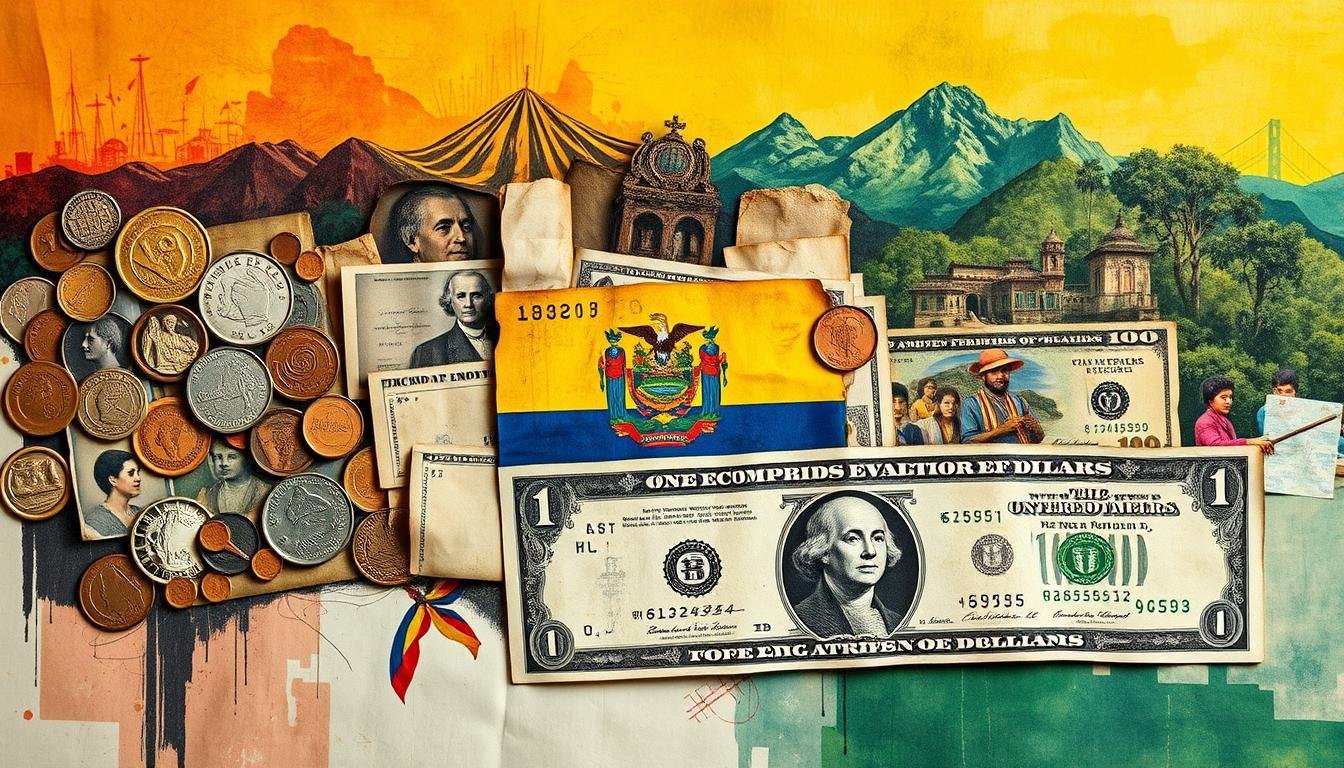
Prepare to explore the rich history of Ecuador’s currency, a journey that spans centuries. It begins with the use of spondylus shells and ends with the adoption of the US dollar. This evolution highlights the transformation of Ecuador’s monetary system1. The Ecuadorian sucre, once the national currency, is now preserved in the Numismatic Museum of the Central Bank of Ecuador1. In 2000, Ecuador switched to the US dollar, leading to a significant reduction in inflation and economic growth2.
The history of Ecuador’s currency is complex and fascinating. The sucre was introduced in 1884 and has seen various monetary standards over the years3. As you learn more, you’ll see how the sucre and the US dollar have influenced Ecuador’s monetary system.
Key Takeaways
- The history of Ecuador’s currency spans centuries, from the use of spondylus shells to the adoption of the US dollar.
- The Ecuadorian sucre served as the national currency prior to dollarization.
- Ecuador transitioned to using the U.S. dollar as its official currency in 2000.
- The sucre maintained an exchange rate with the US dollar until 19833.
- The average inflation rate of Ecuador was significantly stabilized post-dollarization, with economic growth observed thereafter2.
- The history of Ecuador’s currency is a fascinating topic that includes the use of the US dollar and the Ecuadorian sucre.
- The Numismatic Museum of the Central Bank of Ecuador provides insights into the monetary history of Ecuador1.
Early Monetary Systems in Ecuador
In Ecuador’s pre-Columbian era, spondylus shells served as currency. The arrival of the Spanish brought new currency systems4. This period marked the start of a complex monetary history. You’ll see how Spanish colonization significantly shaped Ecuador’s currency.
The Spanish colonization introduced new coins and the first national currency attempts4. Pottery figurines and containers from 3000 to 2500 BCE show early ceramics in the New World4. This indicates early economic activity and trade, influencing early monetary systems.
During the colonial period, Quito and Guayaquil became major administrative centers4. Guayaquil’s population evolved from enslaved and mixed ethnicities to a diverse society by the 19th century4. The Central Bank of Ecuador was founded on August 10, 1927, marking 97 years of operation as of 20245. The BCE stopped issuing sucres on January 9, 2000, when the US dollar became Ecuador’s legal currency5.
For more on Ecuador’s currency history, visit the Ecuadorian currency Wikipedia page. Ecuador’s dollarization has significantly impacted its monetary system, lasting over 15 years6. Sustainable dollarization is seen when public spending is less than one-fifth (20%) of GDP6.
The following table highlights key events in Ecuador’s monetary history:
| Event | Year |
|---|---|
| Establishment of the Central Bank of Ecuador | 1927 |
| Cessation of sucre issuance | 2000 |
| Introduction of dollarization | 2000 |
Ecuador’s early monetary systems have profoundly influenced its economy4. The impact of Spanish colonization and new currency systems has shaped its financial landscape4. Exploring Ecuador’s currency history reveals the complex factors behind its unique monetary system.
The Birth of the Ecuadorian Sucre
The introduction of the Ecuadorian sucre as the national currency was a significant milestone in the country’s economic development7. It was introduced in 1884 and officially withdrawn in 20007. During this time, the sucre’s value was initially linked to 22.5 grams of fine silver in 18847.
The sucre played a vital role in shaping Ecuador’s economic landscape. Its value was stabilized at an exchange rate of 300.933 mg of fine gold or $0.20 USD in 19267. Yet, high inflation rates led to extreme devaluation, prompting the adoption of the U.S. dollar as the official currency in January 20008.
The transition to the U.S. dollar aimed to curb economic instability seen in previous decades8. Adopting the U.S. dollar has provided economic resilience and enhanced purchasing power, compared to the sucre’s inflationary periods8. The Ecuadorian sucre’s history teaches us the importance of a stable national currency in promoting economic development.
| Year | Event | Impact on Economic Development |
|---|---|---|
| 1884 | Introduction of the Ecuadorian sucre | Marked a significant milestone in the country’s economic development7 |
| 1926 | Stabilization of the sucre’s value | Helped to promote economic stability and growth7 |
| 2000 | Adoption of the U.S. dollar as the official currency | Provided economic resilience and enhanced purchasing power8 |
Historical Significance of Ecuador’s Currency Development
Ecuador’s currency development is deeply connected to its political, economic, and social factors. These elements have shaped the nation’s monetary policy and currency stability over time. The government’s role in maintaining currency stability has been critical, with significant changes in monetary policy affecting the overall economy and social impact9. For instance, the average annual GDP growth rate of nearly 9% from 1972 to 1981 profoundly impacted the country’s economic development9.
The economic factors influencing Ecuador’s monetary policy are varied, including inflation, trade, economic growth, and government spending. The average inflation rate of 6.3% per year from 1950 to 1981 significantly affected the economy9. On the other hand, adopting the U.S. dollar as the official currency in 2000 led to historically low inflation levels. The average annual growth rate was 4.1% between 2000 and 201510.
Political Influences on Currency Stability
Political influences have significantly shaped Ecuador’s currency stability. Governments and international organizations have played a key role in the country’s monetary policy. The relationship between government financing sources and currency development is complex, with seigniorage being a notable source of revenue between 1950 and 19819. In contrast, the dollarization period from 2000 to 2015 saw a significant reduction in seigniorage revenues10.
Social Impact of Currency Changes
The social impact of currency changes in Ecuador has been profound, affecting poverty, inequality, and living standards. The average inflation rate of 39% per year between 1982 and 1999 devastated the economy and social welfare9. In contrast, adopting the U.S. dollar led to increased economic stability and a reduction in poverty rates10.
Major Currency Crises Through History
Ecuador has faced several major currency crises, including adopting the US dollar as its official currency. These crises have been marked by economic instability and significantly impacted the country’s economy. The monetary policy has been key in addressing these issues, employing exchange rate regimes and capital controls11.
High inflation rates, large current account deficits, and real exchange rate misalignments have been key factors in these crises12. Ecuador’s history with currency crises is notable, with the 1990s crisis being a prime example. It was characterized by high inflation and a significant decline in the sucre’s value11.
Here are some key statistics on Ecuador’s currency crises:
- Average economic growth in Ecuador during the 1990s: 2.5% per year11
- Average annual inflation rate in Ecuador during the 1990s: 40%11
- Increase in bank deposits as a percentage of GDP from 1990 to 1998: 11 percentage points11

Ecuador’s experience with currency crises has taught valuable lessons for its monetary policy and economic management. Adopting the US dollar as the official currency has helped stabilize the economy and reduce the risk of future crises11.
| Year | Average Economic Growth | Average Annual Inflation Rate |
|---|---|---|
| 1990 | 2.5%11 | 40%11 |
| 1998 | 2.2%11 | 50%11 |
The Path to Dollarization: A Critical Analysis
The journey to dollarization in Ecuador was fraught with economic instability and a complex decision-making process13. From 1972 to 1981, Ecuador’s GDP grew at nearly 9 percent annually. Yet, this growth was overshadowed by high inflation rates, averaging 8.6 percent per year during the same period13.
The decision to adopt dollarization was driven by Ecuador’s economic woes and the need for stability14. The move in 2000 saw a notable drop in inflation and a boost in public approval14.
Key advantages of dollarization include:
- Lowered inflation rates
- Stabilized economy
- Higher public support
Ecuador’s experience offers valuable lessons for nations facing similar economic challenges13. The US dollar, as the global reserve currency, has been instrumental in international trade and finance post-194414.
In summary, Ecuador’s path to dollarization was fraught but ultimately brought economic stability and lower inflation13. The success of such policies hinges on careful decision-making and effective implementation14.
| Year | GDP Growth Rate | Inflation Rate |
|---|---|---|
| 1972-1981 | 9% | 8.6% |
| 1982-1999 | 1.9% | 39% |
| 2000-2017 | 3.7% | one-digit levels |
Impact of Dollarization on Ecuador’s Economy
The adoption of dollarization in Ecuador significantly impacted its economy15. Replacing the sucre with the US dollar aimed to stabilize the economy and attract foreign investment16. This move brought both positive and negative effects. Dollarization led to a reduction in inflation rates, from 96.1% in 2000 to around 5% in subsequent years16. This decrease contributed to an increase in foreign direct investment (FDI) inflows, reaching approximately $1.5 billion by 200816.
Yet, dollarization also had drawbacks, such as the loss of monetary policy independence and the risk of economic shocks15. Ecuador’s economy was heavily reliant on oil and agricultural exports before dollarization, limiting its ability to manage foreign debt amid commodity price declines15. The shift to dollarization led to business bankruptcies and unemployment increases. Specific post-dollarization unemployment rates or poverty levels are not provided in this material15. Despite this, World Bank data shows poverty rates decreased from 70% in 1999 to 28% by 2015 after dollarization16.
Key effects of dollarization on Ecuador’s economy include:
- Reduced inflation rates
- Increased foreign direct investment (FDI) inflows
- Loss of monetary policy independence
- Potential for economic shocks
For more information on the impact of dollarization, visit the World Bank website to learn about its effects on trade and economic growth15.
Ecuador’s experience with dollarization offers valuable lessons for other countries considering this option17. Examining Ecuador’s outcomes helps policymakers understand the complexities involved and make informed decisions about their economic reforms16.
Understanding Modern Ecuador’s Monetary System
Exploring Ecuador’s economy reveals a monetary system marked by a robust financial infrastructure, growing digital payments, and a stable banking sector18. The financial setup is vital for the country’s economic advancement. It focuses heavily on digital payments, now a key part of the monetary system.
Digital payment adoption is surging, with about 50% of transactions in Ecuador being in U.S. dollars post-dollarization18. This shift has made transactions more efficient and cheaper. Loan interest rates have plummeted from 30% before dollarization to around 10% afterward18.
Current Financial Infrastructure
Ecuador’s financial infrastructure is bolstered by a stable banking system, which has seen significant reforms. The banking landscape includes both public and private entities, providing services like mobile payments and online banking. Unemployment rates have dropped to about 5% after dollarization, down from 13% before18.
Digital Payment Adoption
The rise in digital payments is driven by mobile payments and online banking. The sales tax hike from 12% to 15% has affected the economy19. Yet, the non-financial public sector’s annual deficit has decreased from 3.6% in 2023 to 2.0% in June 202419. This shows a positive fiscal management trend.
Banking System Overview
The central bank oversees Ecuador’s banking system, ensuring its stability. Below is a summary of the banking system:
| Type of Bank | Services Offered |
|---|---|
| Public Banks | Mobile payments, online banking, loans |
| Private Banks | Mobile payments, online banking, credit cards |
In conclusion, grasping modern Ecuador’s monetary system involves examining its financial infrastructure, digital payment adoption, and banking system. This analysis provides insight into the country’s economic landscape and the monetary system’s role in fostering growth and development1819.
Lessons Learned from Ecuador’s Currency Evolution
The lessons from Ecuador’s currency evolution are profound for economic policy and global perspectives. Understanding the impact of dollarization is critical. It highlights the importance of exchange rate regimes and capital controls in economic stability20. Ecuador’s journey can guide other nations through similar economic hurdles.
Some key takeaways from Ecuador’s currency evolution include:
- Sound monetary policy is essential for economic stability
- Exchange rate regimes and capital controls significantly influence economic outcomes21
- Global perspectives are vital in economic policy-making
Studying Ecuador’s currency evolution offers a deeper insight into economic policy and global perspectives. This understanding aids in making informed decisions and shaping economic outcomes elsewhere20.
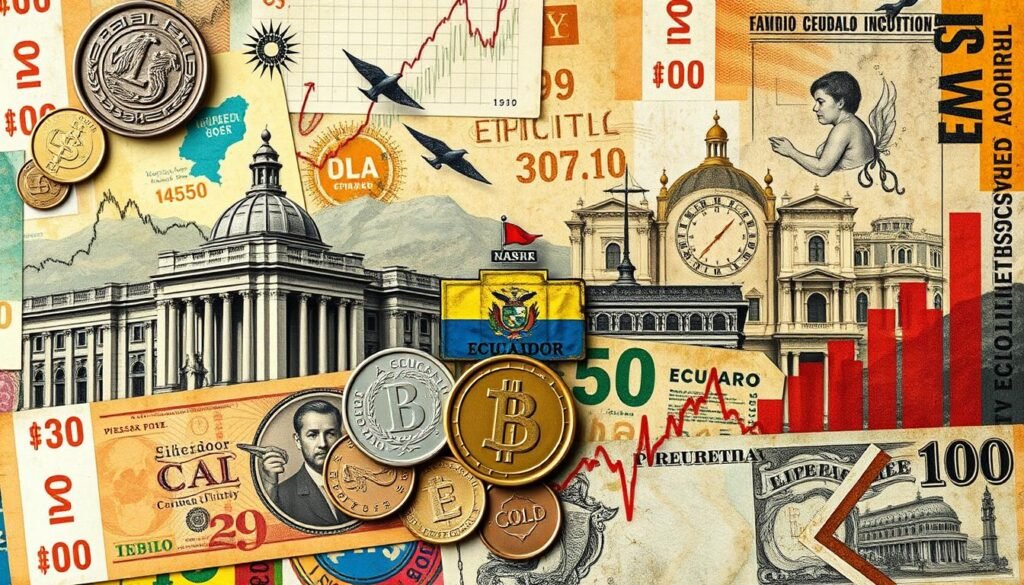
As you proceed, consider the global perspectives and economic policy implications of your choices. This approach fosters a stable and prosperous economic environment21.
Future Outlook for Ecuador’s Monetary Policy
The future of Ecuador’s monetary policy is deeply connected to its economic growth and development22. In 2021, Ecuador’s GDP saw a 4.2% growth, lagging behind the 5.9% average in Latin America22. The country’s GDP had plummeted by nearly 8% in 202022. To boost economic growth, the government must adopt effective monetary policy strategies. This includes adjusting interest rates and exchange rates.
Ecuador faces significant economic hurdles, including a net loss of 92,000 people through migration22. The country also has a substantial US$ 9 billion invested abroad, not directed towards public health or social needs22. To overcome these obstacles, Ecuador needs a detailed future outlook for its monetary policy. This must consider both the risks and opportunities facing the economy.
Several strategies could help Ecuador’s economic growth:
- Implementing policies to attract foreign investment
- Developing a detailed plan to reduce poverty and inequality
- Investing in education and infrastructure to enhance productivity and competitiveness
The future outlook for Ecuador’s monetary policy is intricately complex. It demands a thorough analysis of the country’s economic growth and development objectives23. By crafting a detailed plan and implementing robust monetary policy measures, Ecuador can foster economic growth. This will, in turn, elevate the standard of living for its citizens22.
| Year | GDP Growth | Migratory Balance |
|---|---|---|
| 2020 | -8% | -92,000 |
| 2021 | 4.2% | -92,000 |
Conclusion
Exploring Ecuador’s currency history reveals a complex tapestry influenced by political turmoil and economic crises24. The shift to the US dollar in 2000 marked a significant turning point, stabilizing Ecuador’s financial landscape24. This change has had a profound impact, shaping the country’s economic trajectory.
The transition to dollarization was not without its hurdles, yet it has brought stability and reliability to Ecuador’s economy24. This journey through Ecuador’s currency history teaches us about the significance of sound monetary policies and adaptability in the face of economic shifts24.
Ecuador’s ongoing journey through its monetary system showcases the importance of currency evolution in its economic narrative25. By learning from the past and embracing future opportunities, Ecuador can leverage its currency heritage to foster long-term prosperity25.
FAQ
What were the early monetary systems in Ecuador?
When and why was the Ecuadorian sucre introduced?
What factors have shaped the historical significance of Ecuador’s currency development?
What major currency crises has Ecuador faced, and how has the country addressed them?
How and why did Ecuador transition to dollarization?
What has been the impact of dollarization on Ecuador’s economy?
What is the current state of Ecuador’s monetary system?
What are the key lessons learned from Ecuador’s currency evolution?
What is the outlook for Ecuador’s future monetary policy?
Source Links
- Numismatic Museum in Ecuador – Explore Currency History – https://www.casagangotena.com/blog/activities/numismatic-museum-in-ecuador/
- 5 Things to Know About Money in Ecuador – https://blog.remitly.com/currencies/money-in-ecuador/
- Ecuadorian Currency: A History Lesson – https://travelwithheidi.weebly.com/life-lately-a-blog/ecuadorian-currency-a-history-lesson
- History of Ecuador | Summary, Facts, Flag, & Map | Britannica – https://www.britannica.com/topic/history-of-Ecuador
- Central Bank of Ecuador – https://en.wikipedia.org/wiki/Central_Bank_of_Ecuador
- PDF – https://www.cepal.org/sites/default/files/publication/files/42014/RVI121_Paredes.pdf
- Ecuadorian sucre – https://en.wikipedia.org/wiki/Ecuadorian_sucre
- Ecuador Currency (US Dollar History + Facts) – WhiteboardCrypto – https://whiteboardcrypto.com/ecuador-currency/
- PDF – https://bfi.uchicago.edu/wp-content/uploads/WP_2018-65.pdf
- Helping you organize a trip of a lifetime – Ecuador’s National Currency: The US Dollar… Why? – https://www.cnhtours.com/news/2024/10/5/ecuador-s-national-currency-the-us-dollar-why/
- TCH: Dollarization in Ecuador – https://www.linkedin.com/pulse/tch-dollarization-ecuador-daniel-dematos-cfa-jhpae
- CID Working Paper No. 026 :: Currency Crises: Is Central America Different? by Gerardo Esquivel and Felipe Larrain B., Center for International Development at Harvard University – https://www.hks.harvard.edu/sites/default/files/centers/cid/files/publications/faculty-working-papers/026.pdf
- PDF – https://bfi.uchicago.edu/wp-content/uploads/The-Case-of-Ecuador.pdf
- Dollarization Dynamics in Ecuador and Argentina: Assessing its Viability and Success as a Remedy for Weak Latin American Economies – https://research.library.fordham.edu/cgi/viewcontent.cgi?article=1130&context=international_senior
- PDF – https://www.saintpeters.edu/wp-content/uploads/blogs.dir/270/files/2022/12/Luis-Verduga-The-Effect-of-Dollarization-on-Ecuadors-Development.pdf
- How We Dollarized Ecuador – https://www.lse.ac.uk/school-of-public-policy/events/2021-22/2021-22/How-we-Dollarized-Ecuador
- Case Studies | Dollarization diplomacy: The case of Ecuador and El Salvador – https://medium.com/the-diplomatic-pouch/case-studies-dollarization-diplomacy-the-case-of-ecuador-and-el-salvador-539e9d20383a
- Microsoft Word – Hanke_Rule of Law_Dollarization_Ecuador.doc – https://sites.krieger.jhu.edu/iae/files/2017/04/Hanke_Rule-of-Law_Dollarization_Ecuador.pdf
- Overview – https://www.worldbank.org/en/country/ecuador/overview
- The IMF, Argentina and Ecuador: Have Lessons Been Learned? – https://www.linkedin.com/pulse/imf-argentina-ecuador-have-lessons-been-learned-otaviano-canuto
- Economic history of Ecuador – https://en.wikipedia.org/wiki/Economic_history_of_Ecuador
- Accumulating reserves shouldn’t interfere with Ecuadorian social policies | LSE Latin America and Caribbean – https://blogs.lse.ac.uk/latamcaribbean/2022/07/05/ecuador-protests-2022-reserves/
- BTI 2024 Ecuador Country Report – https://bti-project.org/en/reports/country-report/ECU
- Ecuador Money & Currency – Everything a Traveller needs to know! – https://happygringo.com/blog/ecuador-currency/
- Ecuador – https://en.wikipedia.org/wiki/Ecuador

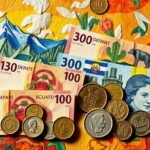

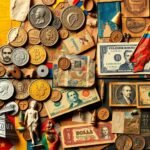

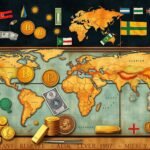
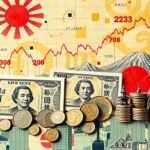
Interesting read! But dont you think Ecuadors shift from Sucre to Dollar was somewhat of a forced economic strategy?
Interesting read, but did the sucres collapse influence the adoption of the USD, or was it more about economic stability?
Interesting read on Ecuadors currency history. But dont you think its odd how the article barely touched on the impact of hyperinflation during the Sucre period? Love to hear your thoughts!
Isnt it curious how Ecuadors switch from the Sucre to the US dollar in 2000 was barely mentioned? Its arguably the most significant event in Ecuadors currency history!
Interesting read, but did the article consider the social impact of changing from Sucre to Dollar in 2000? Quite a pivotal moment, no?
Interesting read, but did the adoption of the US dollar in 2000 really benefit the average Ecuadorian economically?